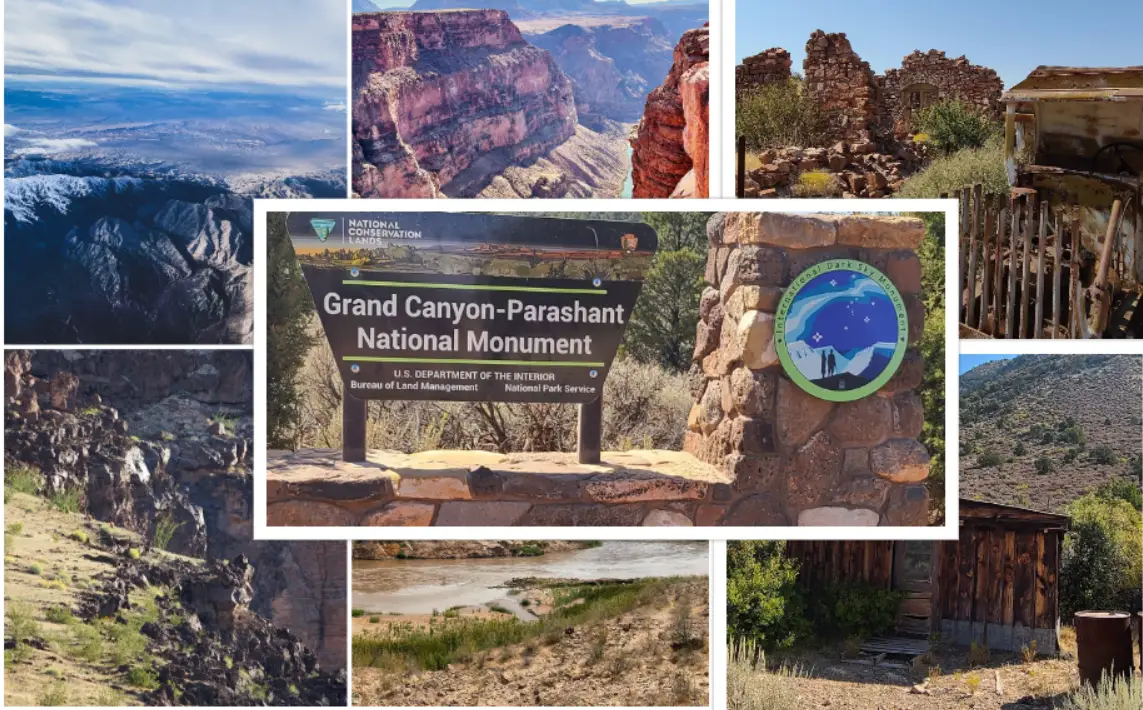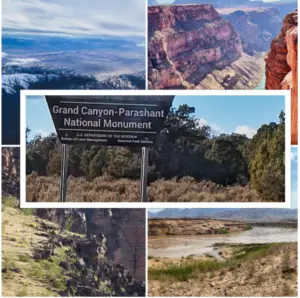Grand Canyon–Parashant National Monument : Interesting Facts, History & Travel Guide

- By
- Aparna Patel
- |
- 1 Apr, 2023
- |

Grand Canyon-Parashant National Monument is a vast and remote area of northwestern Arizona, covering over 1 million acres of public land. This breathtaking natural wonder is home to unique geological formations, historical and cultural sites, and diverse wildlife, making it a must-visit destination for outdoor enthusiasts and nature lovers.
In this blog, we will delve into the interesting facts, rich history, and travel guide for Grand Canyon-Parashant National Monument, providing you with everything you need to know before embarking on your adventure to this stunning location. So let’s begin our journey and discover the wonders of Grand Canyon-Parashant National Monument!
- Grand Canyon-Parashant National Monument is located in northwestern Arizona, covering over 1 million acres of remote wilderness.
- The monument was established by President Bill Clinton in 2000, in order to protect the unique geological formations, historical and cultural sites, and diverse wildlife of the area.
- The monument shares a boundary with the Grand Canyon National Park, forming a contiguous protected area of over 1.2 million acres.
- The name “Parashant” is derived from the Paiute word “pah-she-an-tah”, meaning “tanned elk hide” or “softening of the elk hide”.
- The monument is home to a variety of wildlife, including bighorn sheep, mountain lions, coyotes, and over 250 species of birds.
- The monument is also home to several unique geological formations, including the Shivwits Plateau, Mount Trumbull, and the Grand Wash Cliffs.
- The monument contains many cultural and historical sites, including petroglyphs, historic mining sites, and abandoned homesteads from the early 20th century.
- The monument is a designated International Dark Sky Park, offering some of the best stargazing opportunities in the country.
- Visitors to the monument can enjoy a variety of outdoor recreational activities, such as hiking, camping, backpacking, and off-road vehicle tours.
- The monument is a remote and rugged area, and visitors should come prepared with plenty of water, food, and supplies, as there are no services available within the monument.
Read More:
- Governors Island National Monument : Interesting Facts, History & Travel Guide
- Gold Butte National Monument : Interesting Facts, History & Travel Guide
- Gila Cliff Dwellings National Monument : Interesting Facts, History & Travel Guide
- Giant Sequoia National Monument : Interesting Facts, History & Travel Guide
- George Washington Carver National Monument : Interesting Facts, History & Travel Guide
- Freedom Riders National Monument : Interesting Facts, History & Travel Guide
- Fossil Butte National Monument : Interesting Facts, History & Travel Guide
Information & History of Grand Canyon–Parashant National Monument
The area that now makes up the Grand Canyon-Parashant National Monument has a rich and varied history. For thousands of years, Native American tribes, including the Hualapai, Paiute, and Havasupai, have called the region home. These tribes hunted, fished, and gathered resources from the land, and many of their cultural sites and artifacts can still be found throughout the monument.
In the 19th century, European settlers began to move into the area, drawn by the discovery of valuable minerals such as copper, gold, and silver. The monument contains several historic mining sites, including the famous Grand Gulch Mine, which produced copper and silver from the late 19th century through the early 20th century.
In the early 20th century, the monument was home to several small communities of homesteaders, who lived off the land and raised livestock. Many of the abandoned homesteads and ranches can still be seen today, providing a glimpse into the region’s history and way of life.
The monument was established by President Bill Clinton in 2000, in order to protect the unique geological formations, historical and cultural sites, and diverse wildlife of the area. Today, the monument offers visitors a chance to explore the rugged and remote wilderness of the region, and to learn about its fascinating history and culture.
Visitors to the monument can enjoy a variety of outdoor recreational activities, including hiking, camping, backpacking, and off-road vehicle tours. The monument is also a designated International Dark Sky Park, offering some of the best stargazing opportunities in the country.
Despite its remote location, the Grand Canyon-Parashant National Monument is an important and valuable part of America’s public lands, providing a vital habitat for wildlife, protecting important cultural sites and artifacts, and offering visitors a unique and unforgettable wilderness experience.
Travel Guide for Grand Canyon–Parashant National Monument
- Getting There: The monument is located about 80 miles north of the town of Kingman, Arizona. There are no paved roads within the monument, and visitors should be prepared for rough and rugged driving conditions. Most visitors choose to access the monument via the BLM’s Grand Canyon-Parashant National Monument Visitor Center, located in the town of Meadview, Arizona.
- When to Visit: The best time to visit the monument is during the spring and fall months, when temperatures are mild and the weather is typically dry and sunny. Summer temperatures can be extremely hot, and winter temperatures can be very cold, so visitors should plan accordingly.
- What to See: The monument is home to a variety of unique geological formations, including the Shivwits Plateau, Mount Trumbull, and the Grand Wash Cliffs. Visitors can explore these formations by hiking, backpacking, or taking an off-road vehicle tour. The monument is also home to several historic mining sites, abandoned homesteads, and cultural sites, including petroglyphs and Native American artifacts.
- Camping: Camping is permitted within the monument, but visitors should come prepared with all necessary supplies, as there are no services available within the monument. There are several primitive campgrounds within the monument, and backcountry camping is also permitted.
- Stargazing: The monument is a designated International Dark Sky Park, offering some of the best stargazing opportunities in the country. Visitors can enjoy the night sky by camping or stargazing at one of the monument’s many viewpoints.
- Safety: The monument is a remote and rugged area, and visitors should come prepared with plenty of water, food, and supplies. Visitors should also be aware of the risks of extreme temperatures, flash floods, and wildlife encounters, and should take appropriate precautions.
A visit to Grand Canyon-Parashant National Monument offers a unique and unforgettable wilderness experience, with stunning views, fascinating history, and a chance to explore some of the most remote and rugged terrain in the American West.
More Articles:
- Fort Union National Monument : Interesting Facts, History & Travel Guide
- Fort Stanwix National Monument : Interesting Facts, History & Travel Guide
- Fort Matanzas National Monument : Interesting Facts, History & Travel Guide
- Florissant Fossil Beds National Monument : Interesting Facts, History & Travel Guide
- Fort Frederica National Monument : Interesting Facts, History & Travel Guide
- Yosemite National Park: Interesting Facts, History & Information
- Fort Pulaski National Monument : Interesting Facts, History & Travel Guide
- Fort Ord National Monument : Interesting Facts, History & Travel Guide
FAQ about Grand Canyon–Parashant National Monument
Here are some frequently asked questions about Grand Canyon-Parashant National Monument:
What is Grand Canyon-Parashant National Monument?
Grand Canyon-Parashant National Monument is a vast and remote area of northwestern Arizona, covering over 1 million acres of public land. The monument is managed by the Bureau of Land Management (BLM) and was established in 2000 to protect the unique geological formations, historical and cultural sites, and diverse wildlife of the area.
What is the best time to visit Grand Canyon-Parashant National Monument?
The best time to visit the monument is during the spring and fall months, when temperatures are mild and the weather is typically dry and sunny. Summer temperatures can be extremely hot, and winter temperatures can be very cold.
What activities can I do in Grand Canyon-Parashant National Monument?
Visitors to the monument can enjoy a variety of outdoor recreational activities, including hiking, camping, backpacking, and off-road vehicle tours. The monument is also a designated International Dark Sky Park, offering some of the best stargazing opportunities in the country.
Are there any services available within the monument?
There are no services available within the monument, and visitors should come prepared with all necessary supplies, including food, water, and camping equipment.
Can I camp in Grand Canyon-Parashant National Monument?
Camping is permitted within the monument, but visitors should come prepared with all necessary supplies, as there are no services available within the monument. There are several primitive campgrounds within the monument, and backcountry camping is also permitted.
What safety precautions should I take when visiting the monument?
The monument is a remote and rugged area, and visitors should come prepared with plenty of water, food, and supplies. Visitors should also be aware of the risks of extreme temperatures, flash floods, and wildlife encounters, and should take appropriate precautions.
Are there any fees to enter Grand Canyon-Parashant National Monument?
There are no entrance fees to visit the monument, as it is a public land managed by the Bureau of Land Management. However, there may be fees for certain activities or services within the monument, such as camping or off-road vehicle tours.
